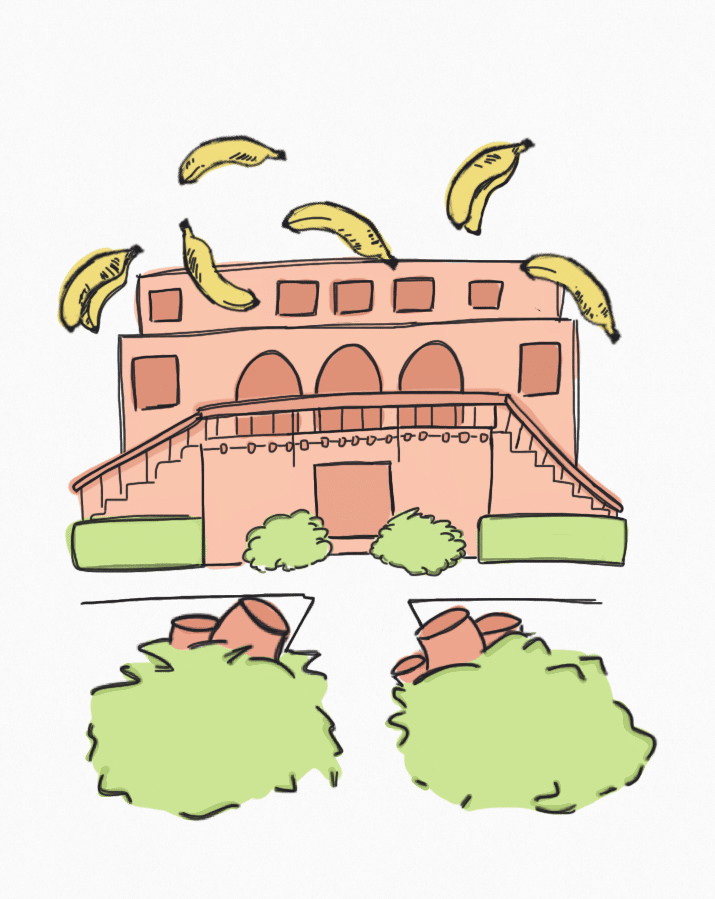I gazed up at the thick trunks growing up from the ground, the leaves sprouting from their limbs slightly off-proportion. The masses of green swallowed the space above my head. As I walked through the organic archway, the iconic Obama portraiture that adorned the outside of Haines Hall greeted me. Banana trees like this didn’t exist in my hometown of Seattle, so the green giants served as a reminder of both where I was and where I had come from every time I walked under them.
When I returned after spring break, the trees were gone. Now, as I walk past the stumps, all I feel is disappointment. I was let down by the communication of our institution and the decision-making process that led to the Haines banana leaf trees downfall.
Unlike most, I was warned of the trees’ dismal fate.
A week or so before I left for spring break, I was walking to Chilcott Hall when President Jonathan Veitch, accompanied by two men I did not know, approached me. Veitch asked me how I would feel if the banana leaves outside Haines were cut down. At the time, one of the men accompanying him mentioned that some “beautiful orange trees” would replace them. As we can see now, there were indeed orange trees planted on the Haines front lawn, but not in a space that replaced the maimed banana trees.
Feeling resistant towards the idea, I asked Veitch why he wanted to cut down the trees in the first place. He told me that the trees disrupted the aesthetic design of Haines, obstructing the view of the building. After further prompting, I told Veitch my honest opinion — I felt the trees were not only a symbol of Haines, but they also meant something to students. And, rather than disrupting it, they naturally framed the building’s architecture.
At that moment, I felt my voice mattered. I appreciated that Veitch took the time to bring me into the conversation, and after I expressed my strong feelings against the plan, one of the men with Veitch said “Well, that settles that,” before we split paths.
As the student body can now see, my commentary on the subject did not “settle that.” Many students returned from spring break to find the same shockingly barren landscape and dismantled trunks. During my first week back, I heard endless complaints from my peers about the trees. Although students from all over campus voiced their discontent, many Chilcott and Haines residents were particularly upset about the sudden change in their living environment.
I am one voice, and I do not expect to alter every decision our institution makes — but if Veitch and the administration at Occidental intend on bringing student voice into decisions — which I agree they should do — then they need to do it in a consistent, transparent and intentional way.
This conversation led me to believe that the administration valued my input, but ultimately, my voice did not sway the decision. After I returned to find the dismal stumps in front of Haines, I emailed Veitch, voicing my opinion on the matter and about our dialogue.
Veitch responded via email that he too was skeptical about the tree removal. He informed me that he consulted a number of students and that there was no clear consensus on what to do about the trees; he then reiterated the argument that the banana trees’ growth obstructed the views of Haines. He did not tell me who he “consulted” with or how he “consulted” students, nor did he respond to my arguments for why the trees should have stayed. He did not seem to recognize or seek ways to alter the decision-making process in the future.
If a student tells you they care about the trees, that should be an indication to continue the dialogue, to follow-up and to look into the impact your decision would have. I do not mean to be unreasonable when asking for the student body to hold equal weight in landscaping decisions. I’m aware that my job as a student is not to be accountable for every tree and part of foliage on this campus.
If the administration seeks to benefit student-administration relations and build trust on campus, then they need to learn from decisions like this. I hope the administration can consider the way students’ lives are also impacted by the decisions they make.
From what I experienced, Veitch randomly consulted students with no formalized process of decision-making. The impact cutting down these trees had on me and our community was clearly not anticipated by the administration. I hope the banana leaves’ demise will be a learning experience for students and administration alike. Without a platform or awareness of the decisions the administration makes on campus, students don’t have an opportunity to share their opinions. It’s on you: faculty, administration, staff — include us. I may speak for the trees, but you should speak for us.
Stella Ramos is an undeclared first year. She can be reached at sramos@oxy.edu.
![]()




































